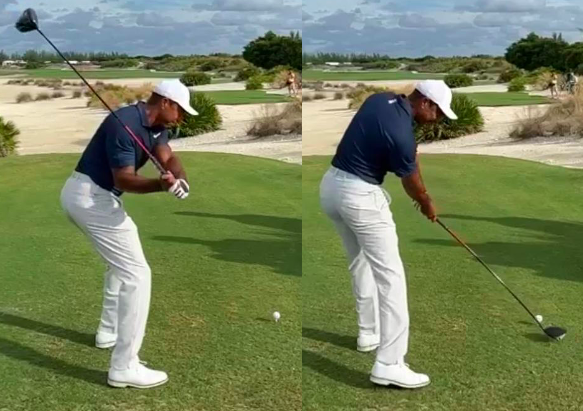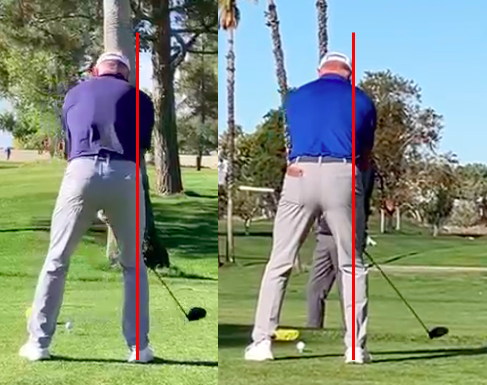Something to think about.
Is your swing inconsistent, especially under pressure? Do you play in pain?
STOP repeating the same swing movements and expecting your results to improve!
Here is a simple explanation of WHY your swing may be inconsistent or cause you pain:
You try to do something in your downswing to make-up-for a position you had in your backswing that needs adjustment. For example,
- Do you try to drop your lead leg down and forward then rotate around it?
- Do you try to shallow your shaft at the start of your downswing?
- Do you try to increase the width of your arms as you start down?
- Do you try some version of ‘keep your butt against a wall/tush line’ to prevent early extension?
Tiger Woods is clearly doing the latter at the 2023 Hero World Challenge (with poor results – from this position and given his current body, he is unable to extend his torso at impact. It is completely scientifically incorrect to say you need to have hip flexion early in the downswing for better push off later on, and based on the pictures below, I rest my case)

In general do you use downswing “match-ups” to compensate for backswing faults?
THEREIN lies your problem!
The human brain controls movement
Its main specialization in a goal-oriented movement (like golf) is to somehow deliver the implement (the golf club) to the target (the ball on the ground).
And ‘somehow’ is not good enough. When you interfere with, or try to alter, the only movements your body is capable of making from the top, you mess up sequencing, location of the club’s low spot and even clubface orientation.
Trying to control a downswing movement can never be reliable.
Why? Because when one body part is tightly controlled, other body parts have to alter their natural motion from the top of your backswing to accommodate that.
So what should you do instead?
Position your body at the top of your backswing so that it cannot help but make all the downswing movements you desire.
So, for instance, Tiger should have a top of backswing position from which he does not artificially have to keep his excessive downswing hip flexion in place – perhaps one of the reasons for his low back injuries!
(Incidentally his current match-ups are anatomically inappropriate for what his body is currently able to do).
An example of practice vs play variability in an elite golfer’s swing (and yours!)
Under pressure, unsuitable backswing movements can produce weird results – from both a performance and an injury perspective.
This elite golfer played a magnificent practice round, but during Day 1 of a very important event felt he was unable to shift forward well and also felt pain on the target side of his lead leg.
His swing is the typically-taught modern swing – shift and turn back, center by the top, and shift and turn on the downswing.
There are so many movements to make in a typical golf swing, for the legs, the torso (the region between the shoulders and hips), perhaps the head, as well as the arms and hands. No one ever tells a golfer the precise order or magnitude of any backswing movement.
The result? Under pressure, when muscles contract faster and more forcefully, movements that are meant to be small might get magnified and big movements might be reduced.
The telltale sign of where it all began for our golfer (even though the hole-direction, camera angle and distance-from-player are quite different) is the last captured frame of ‘shift’ before pelvis rotation began.

This golfer has made a larger shift of both pressure and body parts towards his trail side under pressure. This is what caused his feeling of being stuck on the trail side and not able to shift forward as easily. As, in his downswing, he intentionally tried to shift his shoulders and hips forward and rotate the pelvis back as well, he began to feel his body’s resistance to a move it was not flexible enough to make!
In general, with a typical golf swing that requires so many body parts to make a variety of movements, many things could be slightly different under pressure and all the small abnormal movements could add up to a different top-of-backswing position.
So what should you do instead?
Much better, instead, to keep many variables unchanging from address to impact so there will be less variability going back, and thus also while moving down.
At address, you should position the central parts of your body (head, torso and legs) where they need to be at the start of the ‘downswing’ (the position at which the trail shoulder, in a typical swing, returns once more to being below the lead – ‘early downswing’ or P5 are other terms for the position). And then, not move them at all in the backswing. Doing just this cuts out a lot of sources of error.
Why are movements of those parts so detrimental to consistency? It is their motion that causes a loss of dynamic balance. Moreover, you do not need excessive movement for muscles connected to the torso to fire.
If you have a set-up and swing with very specific steps it is easier to be more consistent. If that same swing is also able to prevent undesirable movements like over-the-top and early extension, so much the better. And if the set-up for such a swing is just different enough to trigger the correct backswing, better still.
Most typical swing changes are unreliable because they are a mix-and-match of old and new. Under pressure that might make you revert to your old swing (Tiger still retains many elements of the stack-and-tilt type swing he was taught some years ago)
For how long, golfers, will you delude yourself into believing that you’re almost there? Or that your putting was poor? Or that it’s your head that needs fixing? Or that you need to improve your course-management strategies?


